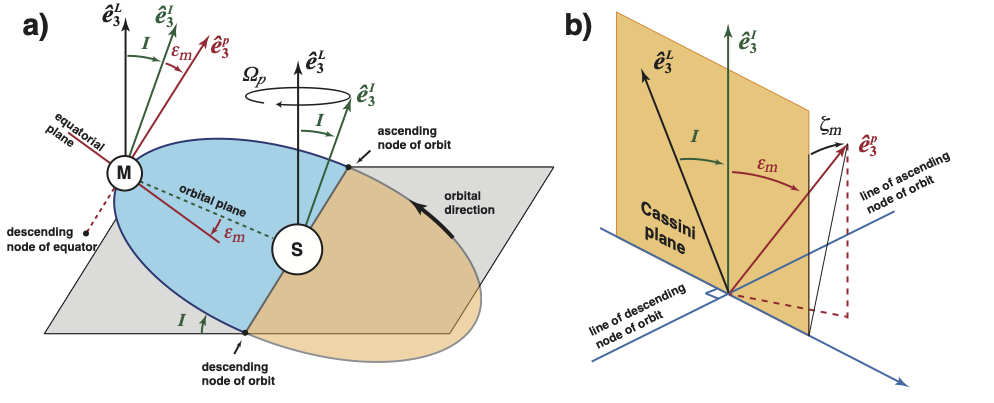The Cassini state of Mercury
Just like the Moon, Mercury is also in a Cassini state. The plane of Mercury's orbit around the Sun is slowly precessing
about an axis fixed in space (the Laplace pole). This entrains a precession of the spin axis of Mercury at the same rate (see Figure 1a below). The angle between the spin axis and the normal to the orbital
plane is known as the obliquity. Observations suggest that Mercury's obliquity is approximately 2 arcmin and that, within measurement errors, the spin axis lies in the plane formed by the Laplace pole and the orbit normal (the Cassini plane).
We know that Mercury has a large metallic core which is liquid. The central part of the core (the inner core) may be solid, but we do not know its actual size. The precession of an entirely solid planet in rigid rotation is different from that of a planet that is layered into a solid outer shell (the crust and mantle) a fluid core and a solid inner core. The observed obliquity of the mantle's spin axis depends on both the
(known) torque from the Sun and the (modelled) coupling between its interior layers. Obliquity
observations may then be used to constrain the interior structure. Likewize, the deviation of the mantle's spin axis away from the Cassini plane is caused by dissipation of rotational energy, a part of it due to friction at the core-mantle and inner core boundaries.
I have recently investigated how the presence of a fluid and solid core affect the Cassini state
of Mercury. I showed that the internal coupling between the solid core, fluid core, and the mantle is
sufficiently strong that the obliquity of the mantle does not depart from that of a rigid planet by more than
0.01 arcmin, an offset smaller than the present-day error in measurements. I also showed that the larger
the solid inner core is, the more the planet behaves as if it were precessing as an entirely rigid body.
In a follow up study, with undergraduate student Ian MacPherson, we have
investigated how tidal deformation and viscous and electromagnetic
coupling at the boundaries of the fluid core with mantle and inner
core lead to dissipation of Mercury's rotational energy. Such
dissipation induce an offset of the spin axis with respect to the
Cassini plane. Our study shows how precise measurements may
constrain these processes, and also how the limited offset suggested
by current observations (< 10 arcsec) implies a lower limit on the bulk
viscosity of the mantle of approximately 1017 Pa s.
In a third paper on this subject, I showed how the precesion dynamics
of Mercury's inner core and fluid core
induce a periodic gravity signal. A future
satellite mission that could measure the
gravity field of Mercury with sufficient
precision could detect this signal, and
confirm the presence of a central, solid
inner core. This would also provide key
constraints on the thermal evolution of
Mercury and on the generation of its
magnetic field.

Figure 1: (a) The orbit of Mercury (M) around the Sun (S) with respect to the Laplace plane (gray shaded rectangle) and the Cassini state of Mercury. The normal to the orbital plane (e3I) is offset from the normal to the Laplace plane (e3L) by an angle I = 8.5330o. The symmetry axis of the mantle (e3p, essentially coinciding with the spin axis) is offset from e3I by an obliquity angle of εm= 2 arcmin. Both e3I and e3p precess about the Laplace plane in a retrograde direction at frequency Ωp = 2π/325,513 yr−1. The blue (orange) shaded region indicates the portion of the orbit when Mercury is above (below) the Laplace plane. Angles are not drawn to scale. (b) In an ideal Cassini state, e3p lies in the plane defined by e3L and e3I (the Cassini plane, orange-shaded rectangle). Dissipation of rotational energy displaces e3p out of the Cassini plane. Figure taken from MacPherson and Dumberry, JGR: Planets, 2022. |
Some of my papers on this topic
Dumberry, M., 2022, The graviy signal of Mercury's inner core, Earth and Space Science, 9, e2022EA002344.
MacPherson, I. and Dumberry, M., 2022, Deviation of Mercury's spin axis from an exact Cassini state induced by dissipation, Journal of Geophysical Research: Planets, 127, e2022JE007184.
Dumberry, M., 2021, The influence of a fluid core and a solid inner core on the Cassini sate of Mercury, Journal of Geophysical Research: Planets, 126, e2020JE006621.

